实验7:基于REST API的SDN北向应用实践
一、基本要求
1.编写Python程序,调用OpenDaylight的北向接口实现以下功能
(1)利用Mininet平台搭建下图所示网络拓扑,并连接OpenDaylight
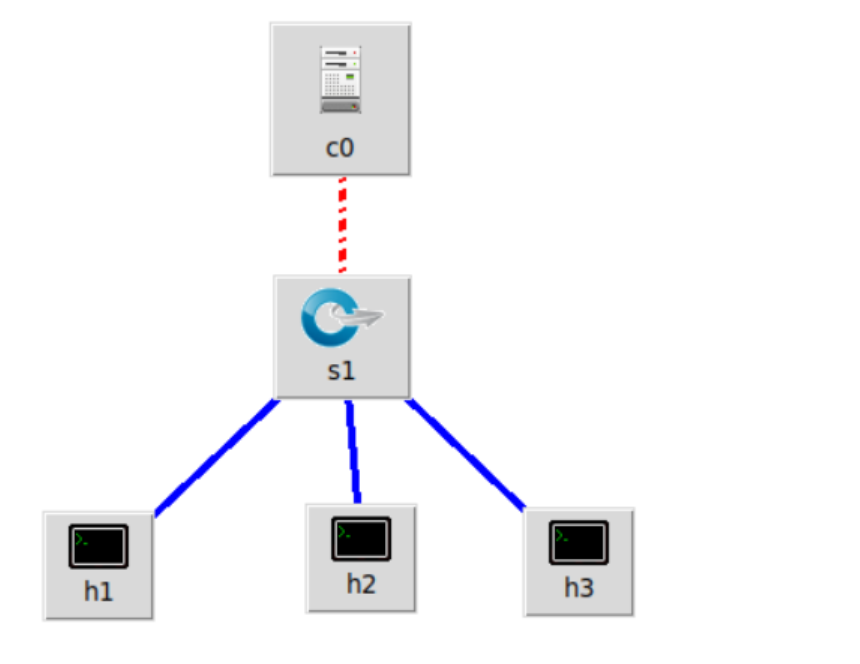
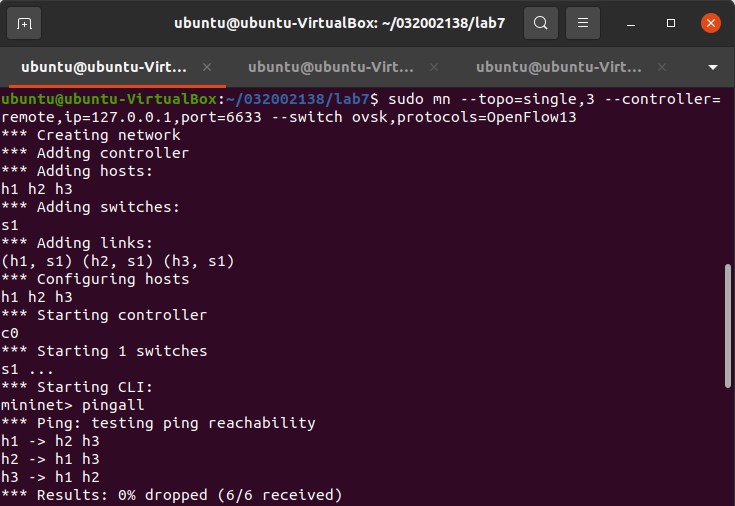
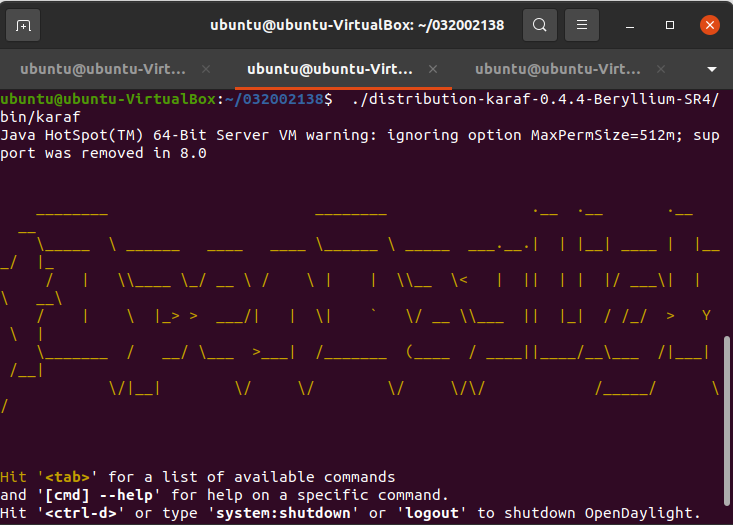
(2)下发指令删除s1上的流表数据
delete.py
import requests
from requests.auth import HTTPBasicAuth
if __name__ == "__main__":
url = 'http://127.0.0.1:8181/restconf/config/opendaylight-inventory:nodes/node/openflow:1/'
headers = {'Content-Type': 'application/json'}
res = requests.delete(url, headers=headers, auth=HTTPBasicAuth('admin', 'admin'))
print (res.content)
(3)下发硬超时流表,实现拓扑内主机h1和h3网络中断20s
timeout.py
#!/usr/bin/python
import requests
from requests.auth import HTTPBasicAuth
if __name__ == "__main__":
url = 'http://127.0.0.1:8181/restconf/config/opendaylight-inventory:nodes/node/openflow:1/flow-node-inventory:table/0/flow/1'
with open("./timeout.json") as file:
str = file.read()
headers = {'Content-Type': 'application/json'}
res = requests.put(url, str, headers=headers, auth=HTTPBasicAuth('admin', 'admin'))
print (res.content)
timeout.json
{
"flow": [
{
"id": "1",
"match": {
"in-port": "1",
"ethernet-match": {
"ethernet-type": {
"type": "0x0800"
}
},
"ipv4-destination": "10.0.0.3/32"
},
"instructions": {
"instruction": [
{
"order": "0",
"apply-actions": {
"action": [
{
"order": "0",
"drop-action": {}
}
]
}
}
]
},
"flow-name": "flow",
"priority": "65535",
"hard-timeout": "20",
"cookie": "2",
"table_id": "0"
}
]
}
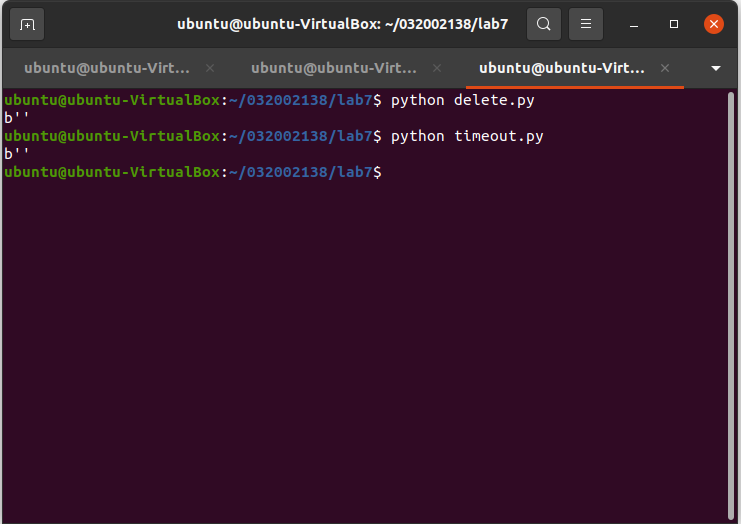
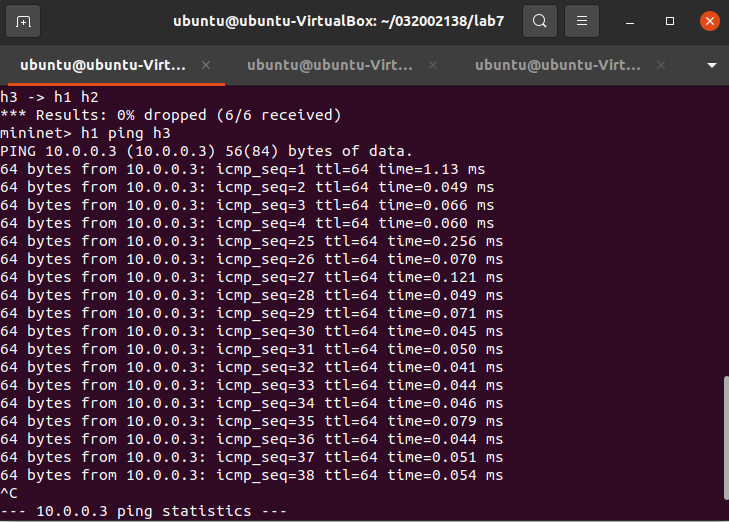
(4)获取s1上活动的流表数
getflow.py
import requests as rq
from requests.auth import HTTPBasicAuth
def http_get(url):
url= url
headers = {'Content-Type':'application/json'}
resp = rq.get(url,headers=headers,auth=HTTPBasicAuth('admin','admin'))
return resp
if __name__ == "__main__":
url='http://127.0.0.1:8181/restconf/operational/opendaylight-inventory:nodes/node/openflow:1/flow-node-inventory:table/0/opendaylight-flow-table-statistics:flow-table-statistics'
resp = http_get(url)
print(resp.content)

2.编写Python程序,调用Ryu的北向接口实现以下功能
(1)实现上述OpenDaylight实验拓扑上相同的硬超时流表下发
timeout_ryu.py
import requests as rq
if __name__ == "__main__":
url = 'http://127.0.0.1:8080/stats/flowentry/add'
with open("./timeout_ryu.json") as f:
jstr = f.read()
headers = {'Content-Type': 'application/json'}
res = rq.post(url, jstr, headers=headers)
print (res.content)
timeout_ryu.json
{
"dpid": 1,
"cookie": 1,
"cookie_mask": 1,
"table_id": 0,
"hard_timeout": 20,
"priority": 65535,
"flags": 1,
"match":{
"in_port":1
},
"actions":[
]
}
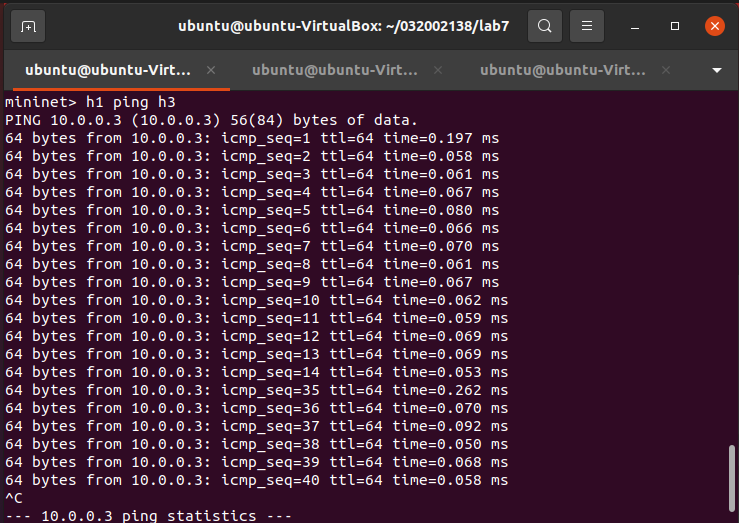
(2)参考Ryu REST API的文档,基于VLAN实验的网络拓扑,编程实现相同的VLAN配置
topo.py
#topo.py
from mininet.topo import Topo
class MyTopo( Topo ):
def __init__( self ):
Topo.__init__(self)
# Add hosts and switches
host1 = self.addHost('h1')
host2 = self.addHost('h2')
host3 = self.addHost('h3')
host4 = self.addHost('h4')
switch1 = self.addSwitch('s1')
switch2 = self.addSwitch('s2')
# Add links
self.addLink(host1,switch1,1,1)
self.addLink(host2,switch1,1,2)
self.addLink(host3,switch2,1,1)
self.addLink(host4,switch2,1,2)
self.addLink(switch1,switch2,3,3)
topos = { 'mytopo': ( lambda: MyTopo() ) }
vlan_ryu.py
import json
import requests as rq
if __name__ == '__main__':
url = 'http://127.0.0.1:8080/stats/flowentry/add'
headers = {'Content-Type': 'application/json'}
f = open('vlan_ryu.json').read()
flows = json.loads(f)['flows']
[rq.post(url, data=json.dumps(flows[i]), headers=headers) for i in range(0, 8)]
vlan_ryu.json
{
"flows": [{
"dpid": 1,
"priority": 1,
"match": {
"in_port": 1
},
"actions": [{
"type": "PUSH_VLAN",
"ethertype": 33024
},
{
"type": "SET_FIELD",
"field": "vlan_vid",
"value": 4096
},
{
"type": "OUTPUT",
"port": 3
}
]
},
{
"dpid": 1,
"priority": 1,
"match": {
"in_port": 2
},
"actions": [{
"type": "PUSH_VLAN",
"ethertype": 33024
},
{
"type": "SET_FIELD",
"field": "vlan_vid",
"value": 4097
},
{
"type": "OUTPUT",
"port": 3
}
]
},
{
"dpid": 1,
"priority": 1,
"match": {
"vlan_vid": 0
},
"actions": [{
"type": "POP_VLAN",
"ethertype": 33024
},
{
"type": "OUTPUT",
"port": 1
}
]
},
{
"dpid": 1,
"priority": 1,
"match": {
"vlan_vid": 1
},
"actions": [{
"type": "POP_VLAN",
"ethertype": 33024
},
{
"type": "OUTPUT",
"port": 2
}
]
},
{
"dpid": 2,
"priority": 1,
"match": {
"in_port": 1
},
"actions": [{
"type": "PUSH_VLAN",
"ethertype": 33024
},
{
"type": "SET_FIELD",
"field": "vlan_vid",
"value": 4096
},
{
"type": "OUTPUT",
"port": 3
}
]
}, {
"dpid": 2,
"priority": 1,
"match": {
"in_port": 2
},
"actions": [{
"type": "PUSH_VLAN",
"ethertype": 33024
},
{
"type": "SET_FIELD",
"field": "vlan_vid",
"value": 4097
},
{
"type": "OUTPUT",
"port": 3
}
]
},
{
"dpid": 2,
"priority": 1,
"match": {
"vlan_vid": 0
},
"actions": [{
"type": "POP_VLAN",
"ethertype": 33024
},
{
"type": "OUTPUT",
"port": 1
}
]
},
{
"dpid": 2,
"priority": 1,
"match": {
"vlan_vid": 1
},
"actions": [{
"type": "POP_VLAN",
"ethertype": 33024
},
{
"type": "OUTPUT",
"port": 2
}
]
}
]
}
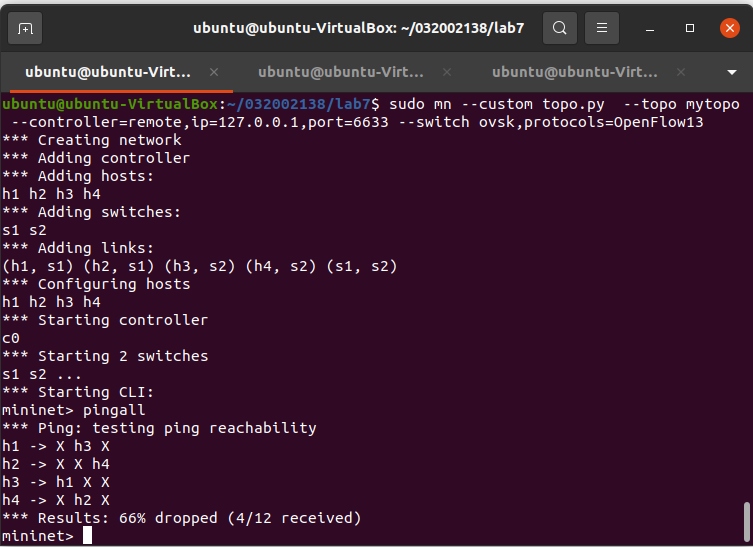
二、进阶要求
OpenDaylight或Ryu任选其一,编程实现查看前序VLAN实验拓扑中所有节点(含交换机、主机)的名称,以及显示每台交换机的所有流表项
get_info.py
import requests as rq
import time
import re
class Get_Info:
def __init__(self, ip):
self.ip = ip
def get_switch_id(self):
url = 'http://' + self.ip + '/stats/switches'
re_switch_id = rq.get(url=url).json()
switch_id_hex = []
for i in re_switch_id:
switch_id_hex.append(hex(i))
return switch_id_hex
def get_flow_table(self):
url = 'http://' + self.ip + '/stats/flow/%d'
switch_list = self.get_switch_id()
all_flow = []
for switch in switch_list:
new_url = format(url % int(switch, 16))
re_switch_flow = rq.get(url=new_url).json()
all_flow.append(re_switch_flow)
return all_flow
def show_names(self):
list_flow = self.get_flow_table()
for flow in list_flow:
for dpid in flow.keys():
dp_id = dpid
switch_num= '{1}'.format(hex(int(dp_id)), int(dp_id))
print('s'+switch_num)
switch_num = int(switch_num)
for list_table in flow.values():
count = 0
for table in list_table:
string1 = str(table)
if re.search("'dl_vlan': '(.*?)'", string1) is not None:
num = re.search("'dl_vlan': '(.*?)'", string1).group(1);
if num == '0' and switch_num == 1:
print('h1')
if num == '1' and switch_num == 1:
print('h2')
if num == '0' and switch_num == 2:
print('h3')
if num == '1' and switch_num == 2:
print('h4')
def show_flows(self):
list_flow = self.get_flow_table()
for flow in list_flow:
for dpid in flow.keys():
dp_id = dpid
print('switch_name:s{1}'.format(hex(int(dp_id)), int(dp_id)))
for list_table in flow.values():
for table in list_table:
print(table)
s1 = Get_Info("127.0.0.1:8080");
s1.show_names();
s1.show_flows();
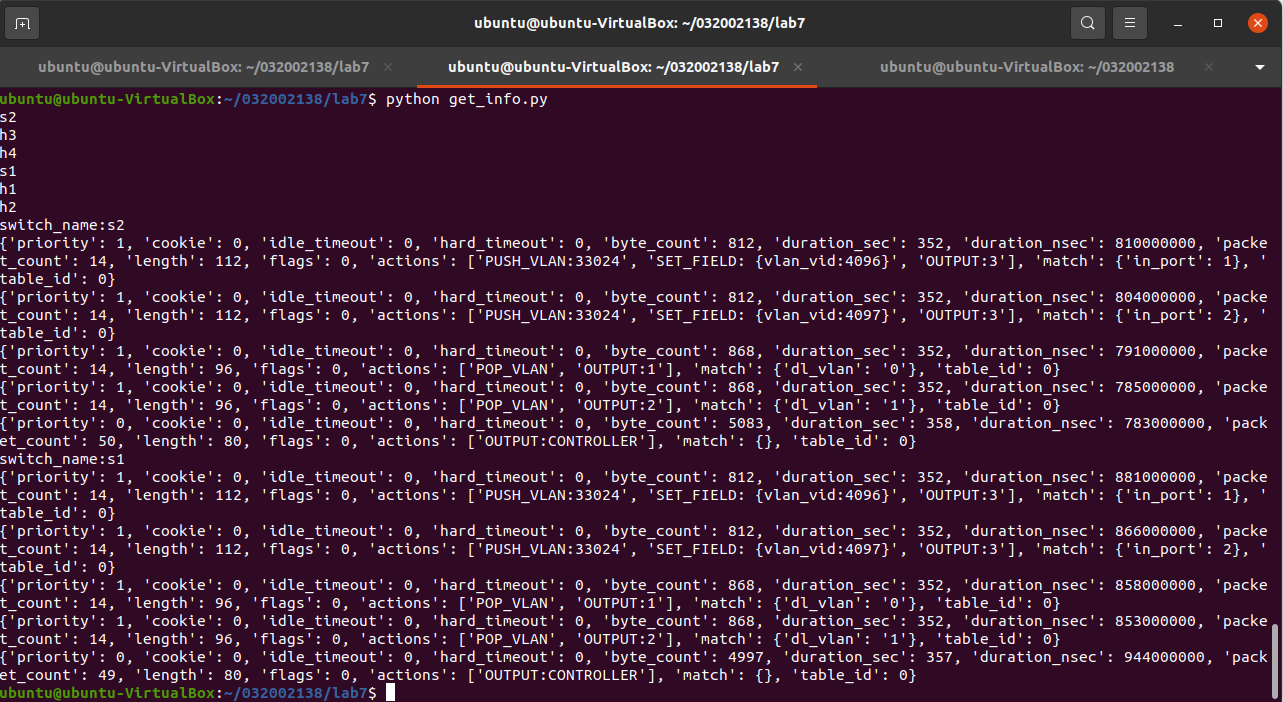
三、个人总结
本次实验总体步骤并不是很多,但和以往相比复杂了不少,综合性较高,而且有许多地方需要格外注意细节,花费了比较多的时间去学习和编写,在实践REST API服务的时候,尝试了好几次都没能成功,最后比对并修改了代码,重新进行运行才解决了问题。总体来说通过这次作业还是收获了很多的知识以及技巧的。



 浙公网安备 33010602011771号
浙公网安备 33010602011771号